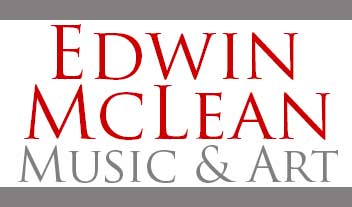Great Fanfare Magazine review of The Music of Edwin McLean CD
EDWIN MCLEAN Sonatas for Harpsichord Nos. 1–3. Incantations for Baroque Oboe and Harpsichord.1 Sonatas for Two Harpsichords Nos. 13 and 2.2 Sonata for Three Harpsichords2, 3 • Elaine Funaro, 2Beverly Biggs, 3Rebecca Pechefsky (hpd); 1Geoffrey Burgess (ob, oba) • ALIÉNOR 84239 (71:04)
Regular readers of Fanfare will have met the combination of composer Edwin McLean and harpsichordist Elaine Funaro before on a Centaur disc, Overture to Orpheus. The piece Incantations also appears on a Classic Concert disc entitled Incantations and Inspirations (reviewed in Fanfare 37:3). North Carolina-based and a Yale graduate, McLean studied with Jacob Druckman and Krzysztof Penderecki. The works heard here span 1991 through 2015 and are pretty much guaranteed to fascinate as much as they bring pleasure.
The Sonata No. 1 for Harpsichord (1991) was McLean’s first piece for that instrument, and it won the Aliénor International Harpsichord Competition. The music is instantly appealing and expertly crafted. There is much invention and inspiration, too, especially in the central “Promenade”; the first movement (“Brisé”) has a modernized Baroque feel to it in its emphasis on arpeggiation (the meaning of “brisé”) and its Couperin-like ornamentation. The final Toccata is simply majestic in this performance by Funaro: it rings our like a carillon, an impression emphasized by the fine, close recording. Funaro’s virtuosity here is for all to hear, her finger strength clear as day. There is a touch of jazz to some of the rhythms.
Written for the present performer, the Sonata No. 2 (1996) begins with an easily flowing Moderato con moto; perhaps most fascinating is the Adagio, again offering a highly ornamented melody. Both first and second movements contain some slightly mechanistic writing, which adds high contrast. Intriguingly, this sonata ends with a slowish movement marked simply “Moderately, slowly, freely.” Initially discursive, always fascinating, and rising to a bright, rhythmic climax, this is a wonderful piece, and the ideal starting point for anyone dipping into the album.
The Sonata No. 3 (2015) is deliberately reminiscent of the First Sonata, to the extent that it, too, begins with a “Brisé” followed by a “Promenade.” Funaro’s rubato in that “Promenade” is particularly noteworthy, ceding to a busy “Animé” finale, wherein Funaro shapes inner lines beautifully while maintaining a perfect onward rhythm.
The way McLean works with rhythm is interesting, as it is never surface-only. His “Tempo di Tango” first movement of the Sonata No. 2 for Two Harpsichords (2014, in which Funaro is joined by Beverly Biggs) is identifiably derived from that dance, but it underpins melodic and motivic play of the highest compositional standard. McLean also writes expertly for the two instruments so that the result is never, ever clangorous. Exchanges of material are managed supremely well. A level of nostalgia underpins the central movement. Again, there is a slow finale (simply marked “Expressively”) that brightens enough to present high contrast to the oboe d’amore’s entrance for the first movement of Incantations (2005). This is highly powerful music; the plaintive, deep oboe d’amore against the very different sound of the harpsichord is most effective. The central movement is marked “Not too fast, but expressive” and includes some fascinating bending of notes from the oboe d’amore. Much of this could be characterized as “cheeky jazz,” perhaps not what one would naturally expect from the combination of oboe d’amore and harpsichord. The finale seems like a ballad, the solo line almost vocalizing its way through. Geoffrey Burgess is a fine, musical player of both instruments here (the Baroque oboe and the oboe d’amore).
The Second Sonata for Two Harpsichords (1992) opens with a Passacaglia, but a remarkably bright-toned one in Latin style, full of jazzy inflections. McLean seems to be experimenting harmonically somewhat in the central movement (“Moderately”), just as he seems to be experimenting more with texture in the finale (“Moderately Fast”). This finale is positively bejeweled and concludes with moments of what can only be described as passages of grandeur. It is a fascinating juxtaposition, and all credit is due to Funaro and Rebecca Pechefsky for their expertise in bringing this music vibrantly to life. And just a final mention is due for the final, wittily dismissive gesture.
Finally, there comes McLean’s Sonata for Three Harpsichords of 1998, commissioned by the Miami Bach Society. Apparently, the composer only took the commission on the understanding he would never be asked to write a sonata for four or more harpsichords. This is a lovely performance by Funaro, Biggs, and Pechefsky, at times riffing with each other, at times creating a super-instrument. It is worth mentioning that it actually sounds as if they had fun performing and recording this (not something I can write every day).The writing is more than expert: McLean differentiates the three instruments by gesture in the second movement at one point. That sense of Latin jazz reappears in the third movement, “Brightly rhythmic,” before a busy finale marked “Freely” takes us to the edge of harpsichord saturation without going beyond it. McLean is right: four would probably be too much.
Incidentally, the front cover reproduces a painting by the composer himself. This is a spellbinding release, one that will surprise and delight in equal measure. Recommended. Colin Clarke






